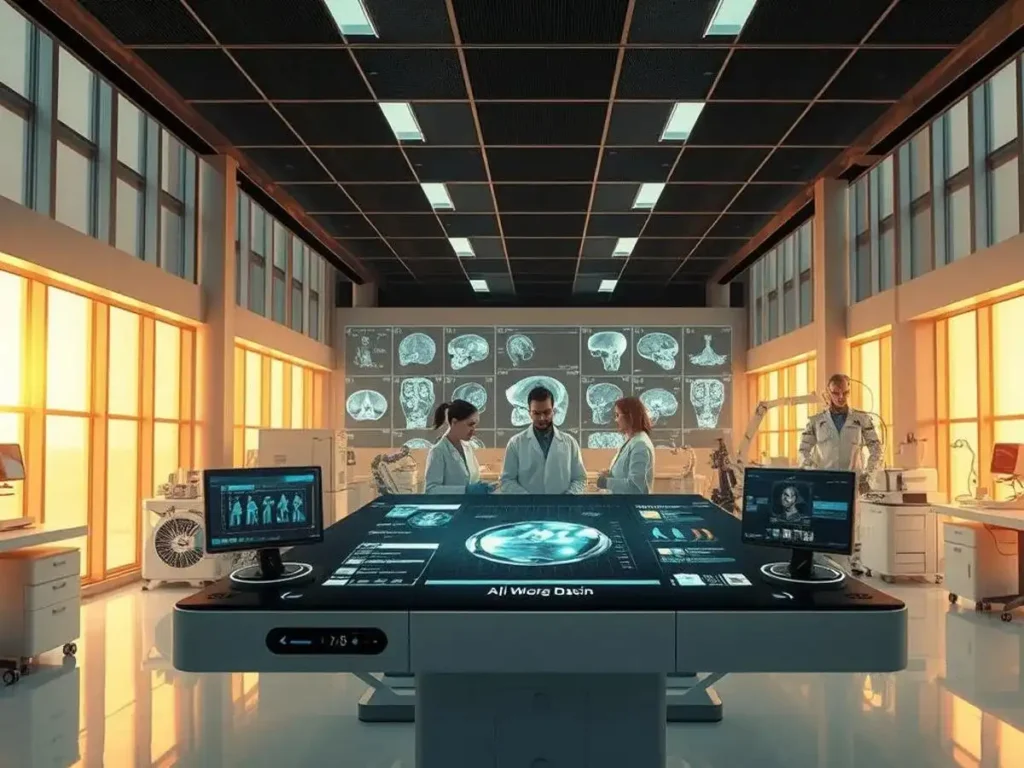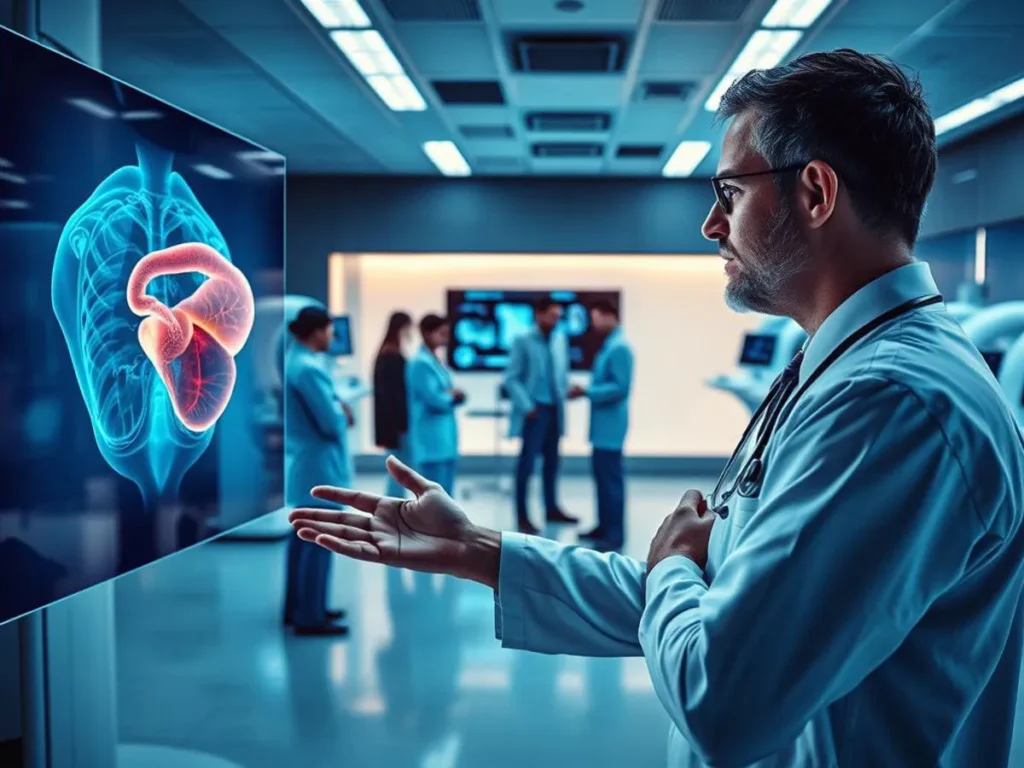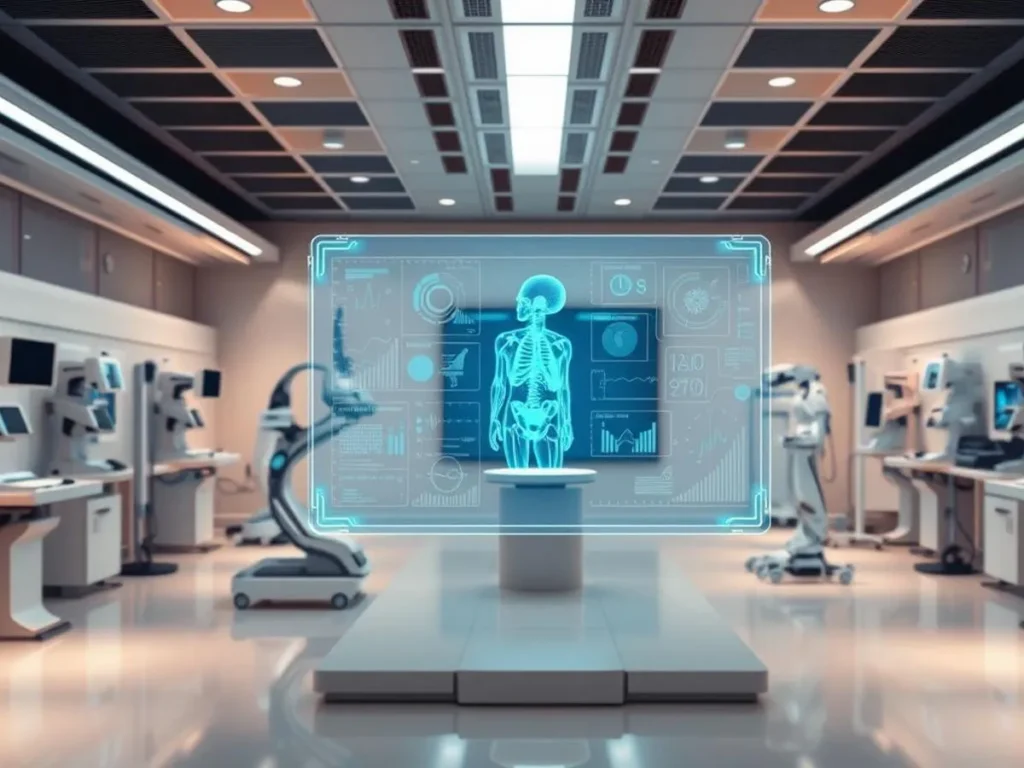By 2025, cutting-edge technology in AI diagnostics will change healthcare. This newest innovation of AI in diagnostics will perfectly change this world in the field of healthcare for sure.

Recent AI advancements have greatly improved medical diagnostics. This lets doctors spot diseases early and accurately.
The use of AI-driven diagnostic tools is changing patient care. It makes care more personal and effective. AI can quickly analyze huge amounts of medical data, shaping healthcare’s future.
This revolutionary technology is not just better for patients. It also makes clinical work easier and cuts healthcare costs.
The Current State of AI in Healthcare Diagnostics
AI is changing healthcare diagnostics. It’s making diagnoses more accurate and efficient.
The Limitations of Traditional Diagnostic Methods
Old ways of diagnosing rely on human eyes and data. These methods can be slow and error-prone. They also face challenges with complex medical data.
Studies show traditional methods often miss diagnoses. This shows we need better tools.
| Diagnostic Method | Accuracy Rate | Time to Diagnosis |
| Traditional Methods | 85% | Several days |
| AI-Assisted Methods | 95% | Within hours |
Recent Advancements in Medical AI Technologies
New AI tech includes advanced algorithms and computer vision. These are used to analyze images, diagnose, and predict outcomes.
Machine Learning Applications in Clinical Settings
Machine learning looks at big data to find patterns. It helps create treatment plans for each patient.
Computer Vision for Medical Imaging Analysis

AI in Medical Imaging
Thanks to these techs, doctors can make better diagnoses quicker. This improves patient care.
The Newest Innovation in AI Diagnostic Technologies
This new innovation brings several key improvements. A major one is the creation of groundbreaking neural network architectures for spotting diseases.
Groundbreaking Neural Network Architectures for Disease Detection
Neural networks are getting better at learning from data. This lets them find diseases more accurately. Two main parts of these architectures are:
Self-Learning Diagnostic Algorithms
These algorithms can look through lots of medical data. They learn and get better at diagnosing over time. This self-learning ability is a big step in AI diagnostics.
Multi-Modal Data Integration Capabilities
They can mix data from different sources like images, genes, and medical records. This multi-modal data integration makes diagnoses more accurate.

Revolutionary Molecular-Level Diagnostic Tools
Another revolutionary concept is molecular-level diagnostic tools. These tools check genetic material and other markers to spot diseases early.
| Diagnostic Tool | Description | Benefits |
| Neural Network Architectures | Advanced AI models for disease detection | Improved accuracy, early detection |
| Molecular-Level Diagnostic Tools | Analysis of genetic and molecular markers | Analysis of data to predict patient outcomes |
| Predictive Analytics | Analysis of data to predict patient outcomes | Preventive care, reduced healthcare costs |
State-of-the-Art Predictive Analytics for Preventive Care
Predictive analytics helps forecast patient outcomes and spot health risks. AI analyzes big datasets to help doctors prevent diseases.
This use of AI in diagnostics is a big modern development in healthcare. It promises better patient care and lower healthcare costs.
Transformative Impact on Patient Care and Clinical Outcomes
AI diagnostics is changing patient care and clinical results. It uses state-of-the-art design and advanced innovation. This makes disease detection more accurate and faster, tailors treatments, and makes healthcare more accessible.
Enhanced Accuracy and Early Disease Detection Rates
AI diagnostics boosts disease detection accuracy and speed. It looks through vast medical data to find patterns humans might miss. This leads to quicker treatments and better health outcomes.
This makes diagnostic tests more reliable. For diseases like cancer, where early detection is key, this is crucial.
Personalized Treatment Plans Through Advanced AI Analysis
AI diagnostics helps create personalized treatment plans for each patient. It looks at genomic data, medical history, and lifestyle. This way, doctors can offer treatments that are more likely to work.
This approach to medicine is a big step forward. Instead, it focuses on understanding each patient’s unique needs.
Democratizing Healthcare Access Through Innovative AI Solutions
AI diagnostics is also making healthcare more accessible. It does this through remote diagnostics. Patients can get medical checks and monitoring without going to a hospital.
Remote Diagnostics for Underserved Communities
Remote diagnostics help close the healthcare gap in underserved areas. It brings medical expertise to places where it’s hard to find. This is great for patients in rural or isolated spots.
Cost-Effectiveness of AI-Powered Healthcare
AI in diagnostics is also saving money. It makes diagnostic processes faster and reduces the need for extra tests. This lowers the cost of healthcare for everyone.
| Benefits | Description | Impact |
| Enhanced Accuracy | AI algorithms improve diagnostic accuracy | Better patient outcomes |
| Personalized Treatment | Tailored treatment plans based onindividual profiles | More effective therapies |
| Remote Diagnostics | Tailored treatment plans based on individual profiles | Increased healthcare access |
| Cost-Effectiveness | Reduced need for redundant testsstreamlined processes | Lower healthcare costs |
Navigating Implementation Challenges in Modern Healthcare Systems
AI is changing healthcare diagnostics, but the industry faces many challenges. To integrate AI diagnostics well, we need to tackle regulatory, technical, and ethical issues. This requires a detailed plan.
Regulatory Frameworks and Approval Processes for AI Medical Devices
The FDA in the US is key in approving AI medical devices. They check if these devices are safe and work well. Regulatory rules need to keep up with AI’s fast growth to help approve devices safely.
It’s important to test AI algorithms with patient data to make sure they’re accurate and reliable for everyone.
| Regulatory Aspect | Description | Impact on AI Diagnostics |
| FDA Approval | Ensures the safety and efficacy of AI medical devices | High |
| Algorithm Validation | Clinical testing for accuracy and reliability | High |
| Post-Market Surveillance | Monitoring of AI device performance post-approval | Medium |
Data Privacy, Security, and Ethical Considerations
Keeping patient data safe and private is essential. We need strong security and follow rules like HIPAA.
We also need to think about AI bias and how clear AI decisions are. This builds trust in AI diagnostics.
Integration with Existing Healthcare Infrastructure and Workflows
AI diagnostics need to fit into current healthcare systems and workflows smoothly. They must work with different electronic health record (EHR) systems. And they should be easy for users to handle without interrupting work.
By tackling these challenges with new solutions and modern methods, healthcare can use AI diagnostics to better care for patients. This will improve health outcomes and care quality.
Conclusion: Shaping the Future of Healthcare Through AI Innovation
The newest innovation in AI diagnostics is set to change healthcare in 2025 and beyond. It uses cutting-edge technology to transform how we detect and treat diseases.
This technology has the power to greatly improve patient care and outcomes. It finds patterns and predicts outcomes better than old methods.
As healthcare keeps adopting AI diagnostics, we’ll see better disease detection and treatment plans. We’ll also get more access to quality care. The future of healthcare is bright, thanks to AI innovation.
Table of Contents
FAQ
What is the newest innovation in AI diagnostics?
The latest in AI diagnostics includes new tech like advanced neural networks and molecular tools. These tools help find diseases early and improve care.
How is AI being used in healthcare diagnostics?
AI is changing healthcare by using machine learning and computer vision.
What are the benefits of AI diagnostics in patient care?
AI diagnostics offer better accuracy and early disease detection. They also help create personalized treatment plans. Plus, they make healthcare more accessible to everyone.
What are the challenges associated with implementing AI diagnostics?
Implementing AI diagnostics faces several hurdles. These include getting through regulatory steps and ensuring data privacy. It also involves fitting AI into current healthcare systems.
How will AI diagnostics shape the future of healthcare?
AI diagnostics will change healthcare by offering new ways to detect and prevent diseases. This will lead to better health outcomes and a more efficient system.
What is the role of machine learning in AI diagnostics?
Machine learning is key in AI diagnostics. It allows for self-learning algorithms and combining different data types. This boosts the accuracy and speed of disease detection.
How does AI diagnostics improve access to healthcare?
They also offer affordable solutions. This makes healthcare more available and affordable for all.


2 thoughts on “The newest innovation in AI Diagnostics: Remarkable Revolution in Healthcare 2025”